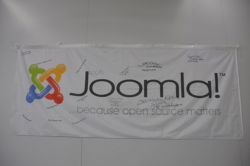Drupal und Joomla sind kostenlose Open-Source-Content-Management-Systeme (CMS) zum Veröffentlichen von Webinhalten. Während Drupals Build-from-Scratch-Ansatz eine größere Vielseitigkeit ermöglicht, ermöglichen die integrierten „Kern“ -Inhaltstypen von Joomla eine schnellere und einfachere Implementierung. Sowohl Drupal als auch Joomla wurden in PHP entwickelt und unter der kostenlosen GNU General Public License (GPL) lizenziert.
Contents
Vergleichstabelle
| Drupal | Joomla | |
|---|---|---|
| Introduction (from Wikipedia) | Drupal ( /ˈdruːpəl/) is a free and open-source content management system (CMS) and content management framework (CMF) written in PHP and distributed under the GNU General Public License. It is used as a back-end system for at least 1.5% of all web | Joomla is a free and open source content management system (CMS) for publishing content on the World Wide Web and intranets and a model–view–controller (MVC) Web application framework that can also be used independently. |
| Operating system | Cross-platform | Cross-platform |
| Website | drupal.org | joomla.org |
| Development status | Active | Active |
| Written in | PHP | PHP |
| Type | Content management framework, Content management system, Community and Blogging software platform | Content management system |
| Developer(s) | Dries Buytaert & Drupal.org Community | The Joomla Project Team |
| License | GPLv2/GPLv3 | GNU General Public License |
| 3rd Party Extensions/Plug-ins Avaliable | 17,257 as of 7/13/2015 | 10223 as of 2/6/2013 |
| Stable release | 7.26 / January 15, 2014 | 1.7.2 / October 17, 2011; 9 days ago (2011-10-17) |
| Size | 11.4 MB (core) | 7.8 MB (compressed) 20.9 MB (uncompressed) |
| Available in | Multilingual | Multilingual |
| Recommended Usage | Large projects where scalability and versatility matter. | Small to medium projects looking for an intuitive interface and standardized capabilities. |
| Example Popular Websites | Whitehouse.gov, Postoffice.gov.uk | Linux.com, Guggenheim.org |
| Accessibility | High barrier to entry; steep learning curve | Very accessible, flexible; user and designer friendly |
| SEO Capabilities | Strong SEO capabilities | Limited SEO capabilities |
| Usage Statistics | Roughly 2.0% of all websites worldwide. | Roughly 3.3% of all websites worldwide. |
| Security | Highest quality, backed by proven track record | Relatively weak, exploit list is substantial |
| Forums/community | Growing, technical heavy | Vast volunteer network |
Background
First released in 2001 by its developer, Dries Buytaert, Drupal is among the older CMS systems in popular use today. It began as the software behind a message board called drop.org, created by Buytaert. Drupal’s name derives itself from the English pronunciation of the Dutch word drupel , which means “to drop.”
<iframe width=”640″ height=”360″ frameborder=”0″ allowfullscreen src=”https://www.youtube.com/embed/rF1X12PE6PY?iv_load_policy=3&rel=0″></iframe>
Joomla is named from the phonetic spelling of the Swahili word jumla, meaning “all together.” Released in 2005, Joomla arose as a fork (a new development group that takes source code in a new direction) of Mambo, the predecessor CMS system on which Joomla’s original code was based.
<iframe width=”640″ height=”360″ frameborder=”0″ allowfullscreen src=”https://www.youtube.com/embed/Qjnc0H8utks?iv_load_policy=3&rel=0″></iframe>
Usage
Drupal and Joomla share several useful attributes. Both are open-source and maintain robust development community bases. They are written in PHP , and both are licensed under a GNU General Public License , which allows end users to use, modify, study, and copy the software. This freedom has allowed the sizable Drupal and Joomla developer communities to flesh out the functionality of both platforms with wide-ranging expansions and modules.

The Joomla Banner
On one hand, Drupal is often favored by developers for its build-from-scratch approach. This allows for immense flexibility in functionality, at the cost of a steeper learning curve. It also allows for a greater degree of scalability, as websites and applications can be designed from the ground up for complex and large-scale functions.

Drupal logo made out of Legos
Joomla, on the other hand, pairs the standard functionalities of a “web 2.0” website with widespread support for themes. It trades the coding flexibility and complexity offered by Drupal for comparative ease of use and aesthetics. It offers more ready-built options in the form of extensions and templates that allow for faster and easier setup at the cost of some the flexibility in scale and complexity afforded by Drupal.
Interface
Both have welcoming interfaces. Drupal is organized into various tabs. If the content editing tab is opened, users can only complete that task. Fortunately, the controls adjust to what is pertinent to the page you have opened. Unfortunately, it closes off certain options forcing you to move to a new panel.
For Joomla, just about every editing option is visible at once. This includes the article manager, the image selections, content editing, design options, etc. It is all there for a full appetizing view.
Accessibility
Drupal is inherently complex and has a significantly steep learning curve. There is no toolbar editor; users must know html and implement the code right into the text in order to edit text.
Joomla contains a toolbar and an html editor embedded into the platform. Joomla is often considered vastly more accessible because of the limits placed on extensions, the layout, and the size of the site out of the box (upon immediate download).
An ‘Instant-On’ option for Joomla cuts off all the intense coding features and allows Joomla to exist primarily as a basic website editing system, unlike Drupal which requires a ground-up design for every website, theme and project.
This video compares Drupal to Joomla:
<iframe width=”640″ height=”360″ frameborder=”0″ allowfullscreen src=”https://www.youtube.com/embed/C0cqch85d_U?iv_load_policy=3&rel=0″></iframe>
Security
Both systems are very well protected, Going by the track record Drupal is seems to have a more robust security. However, researching the overall exploit list (i.e. sites compromised on each platform) shows that going by the type of sites compromises, Joomla is far more protected.
Community
Drupal is a tech community through and through. The user base is smaller, and assistance will be complicated but very useful when understood. You are expected to know the technical aspects of your own website. Drupal is financially backed by Acquia Corporation.
The Joomla community is much larger, but the users slant a bit less tech-oriented than Drupal. Joomla’s larger community has allowed them to be 100% volunteer-driven.
If an active user community is important, it is worth noting that Automattic’s WordPress has a larger, more robust community than either Drupal or Joomla do. There are two versions of WordPress: WordPress.com , which is a user-friendly and hosted service, and WordPress.org , which is where users can find the downloadable, open-source WordPress script that is a more direct “competitor” to Drupal and Joomla.
Trivia
- Whitehouse.gov runs on Drupal
- Joomla is the second most popular CMS in the world
- Drupal began as a tech message board in the early 90’s
Recent News
References
- Wikipedia: Joomla
- Wikipedia: Drupal
- Drupal and Joomla – CMS Expo
- CMS – w3techs.com
- 10 Most Popular Websites Using Joomla! – The Joomla Community Magazine
- Site builder shootout – Computer World